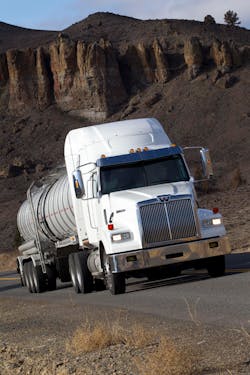Reducing Downtime Begins With Spec’ing New Equipment
Planning strategies for reducing maintenance and downtime should begin when spec’ing new equipment. Two particular areas to focus on, along with some key considerations, are chassis and cabs.
Chassis
- Air and electrical failures - Air and electrical failures account for a great portion of downtime and the cause is often difficult to locate. However, these failures can be avoided if air and electrical lines are bundled and securely mounted.
Every Western Star features robust mounting of the air and electrical bundles all the way to the end of the frame. The bundles are securely fastened and suspended away from the frame rail to ensure debris won’t chafe the lines and cause an electrical short or air leak.
- Crossmembers - Truck chassis’ undergo enormous twisting stress. Choosing the right crossmember and frame fastener can eliminate downtime.
- Fasteners - The use of Grade 8 chassis fasteners, instead of Huck bolts, allow inspection/re-torque, and don’t require a torch to remove, which greatly reduces downtime.
- Suspension - Spec'ing the appropriate type of suspension will help ensure durability, reliability and ride quality.
- Frame Strength - Frame strength is very critical, and depending on the application, it could be the cause of a catastrophic failure and a great safety concern.
The key measurement truck manufacturers and body builders consider is RBM - resistance to bending moment. This is a calculation used to compare frames that have different characteristics.
- Batteries - In-cab batteries free-up frame space for other frame mounted components and place the batteries in a more controlled environment with less vibration.
Cab
- Stone chips and broken windshields are a reality regardless of truck brand. A two-piece windshield makes it easier and less costly to repair.
- Steel or aluminum construction? A piece of aluminum of a given thickness is lighter than a piece of steel of the same thickness. It is also weaker. When aluminum is used for truck cab construction, the sheeting is much thicker than that of a cab made of steel.
In comparison, the weight of an aluminum cab is similar to a steel cab and likely not as strong.
- Cab rivets or welds? Riveted aluminum cabs not only don’t look good, they also permit corrosion. Western Star Trucks have a welded steel cab made of galvannealed steel. This type of steel provides the ultimate in strength, corrosion resistance and good looks.
- Door Hinges - There are basically two types of door hinges: piano hinges and forged steel, recessed hinges. Piano hinges are simple, door-length hinges that are open to the elements and get sloppy over time.
Forged steel, recessed door hinges are hidden from the elements and provide much smoother and maintenance-free operation over the life of the truck.
